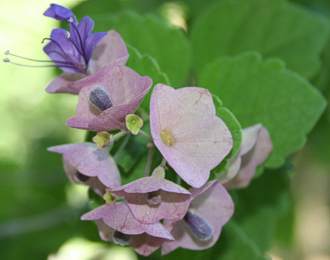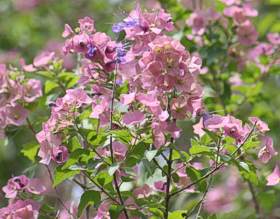Karomia speciosa
Karomia speciosa (Hutch. & Corbishley) R.Fern. forma speciosa
Family: Lamiaceae
Common names: southern chinese hats, wild parasol flower (Eng); sambreelboom (Afr). (= Holmskioldia speciosa )
SA Tree No: 668
Introduction
This shrub to small tree with its two-tone dark and light green leaves produces the most interesting profusion of paper-like flowers with a pink and purple colour combination. A truly great addition to a summer garden in cooler temperate areas, it is deciduous and loses its leaves during winter. If, however, your garden is situated in a more sub-tropical area the plant may prove to be evergreen.

Description
Description
This is a deciduous shrub or small tree ranging in height from 1- 6 m. It is a medium fast grower and is relatively long lived. The main stem is either single- or multi-stemmed, with finely striated branches of pale brown. (Striated: having narrow lines or grooves running more or less parallel). The bark, which is pale grayish-brown, is smooth.
The leaves, which occur opposite each other on the stem, are variable in shape ranging from oval and egg-shaped to oblong, meaning it is long and narrowly shaped. The margins of the leaves are roughly toothed and the colour is decidedly two-toned with an olive- or dark green above to a paler green below. The leaves are characterized by a soft texture with fine hairs occurring on both surfaces.
The flowers are produced in profusion near the ends of the branches, where they form small clusters from November to April. The flowers, which make this such an attractive shrub a must to have in a summer garden, are made up of two colours. The base of the flower, called the calyx, is a pink to mauve colour and often has a paper-like texture, while the main part of the flower is a deep blue to violet colour. It often happens that the main part of the flower falls off leaving the pink base behind, affording the plant a splash of colour long after the flowers have officially disappeared.


The fruit, produced between March and July, are carried in the persistent flower base (calyx). They are very small and rather inconspicuous, consisting of 4 lobes and a hairy surface.
Conservation Status
Status
None.
Distribution and habitat
Distribution description
Karomia speciosa occurs naturally in the following South African provinces: northernmost KwaZulu-Natal, Mpumalanaga and Limpopo. It also occurs in the neighboring African state of Swaziland and north into Tropical Africa.
It is found naturally in bush or wooded areas on hot, dry, rocky slopes as well as in riverine thickets.
Derivation of name and historical aspects
History
The family to which Karomia speciosa belongs, Lamiaceae, is also known as the Sage or Mint family. It is a very large family consisting of herbs and shrubs of which many are well known for their aromatic properties. Some of the plants in the family are known for their essential oils and as popular ornamentals in gardens.
The genus Karomia is represented by only one specie of which two forms occur, Karomia speciosa forma speciosa, which is being discussed in this article and Karomia speciosa forma flava, which is known to have yellow flowers.
The species name speciosa is Latin for splendid or showy and was undoubtedly chosen because of the showy flowers that make this a beautiful garden subject.
Ecology
Ecology
The nectar rich flowers attract insects such as butterflies and carpenter bees, which in turn are responsible for pollinating the plants. Nectar eating birds are also known to visit the flowers of this plant occasionally.
Uses
Use
Apart from being used as a garden subject no other uses for this plant are known.

Growing Karomia speciosa
Grow
Karomia speciosa is a medium fast growing, long-lived shrub or small tree that prefers full sun although it can tolerate dappled shade. In sub-tropical conditions this plant has proved to be evergreen, whereas in colder more temperate regions it is known to be deciduous. It is semi frost resistant and needs to be watered regularly, at least once a week.
It can be grown from seed or from cuttings.
If cuttings are taken be sure to take it from the previous year's wood and not from new growth.
If grown from seed collect the tiny fruiting bodies when they have turned brown, planting the whole fruiting body in a mixture of two parts good soil and one part clean river sand. Place it in a shady spot in your garden and water once a week. Germination of the seed takes place after approximately 3 weeks. Transplanting the seedlings into bags should be done if the seedlings are more or less 100mm in size. Note that only 30% of the seed will germinate, i.e. the more seed you plant the better your results will be.
References
- Germishuizen, G & Meyer, N.L. (ed.). 2003. Plants of southern Africa: an annotated checklist. Strelitzia 14. National Botanical Institute, Pretoria.
- Schmidt, E.; Lotter, M & McCleland, W. 2002. Trees and shrubs of Mpumalanaga and Kruger National Park. Jacana Publications, Johannesburg.
- Palgrave, K.C. 2002. Trees of Southern Africa. New Edition. Struik Publishers. Cape Town.
Credits
Lou-Nita Le Roux
Lowveld National Botanical Garden
January 2009
Plant Attributes:
Plant Type: Shrub, Tree
SA Distribution:
Soil type: Sandy
Flowering season: Late Summer
PH: Neutral
Flower colour: Purple, Pink
Aspect: Full Sun, Morning Sun (Semi Shade), Afternoon Sun (Semi Shade)
Gardening skill: Average
Special Features:
Horticultural zones








Rate this article
Article well written and informative
Rate this plant
Is this an interesting plant?
User Comments
Francine Hattingh, South Africa
November 18, 2017 at 4:50 PMThis grows well in my Durban North garden.
Login to add your Comment
Back to topNot registered yet? Click here to register.